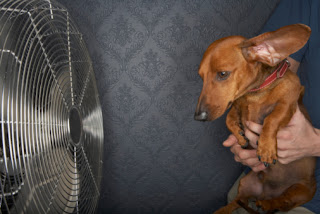Unfortunately, the only thing normal about noisy breathing
for dogs with "pushed-in" faces is that it is an expected response to
a shortened upper jaw, which creates excess soft tissue in the back of the
throat.
Some dogs are
affected to the point where they experience brachycephalic (the scientific term
for breeds with pushed in faces) obstructive airway syndrome or BOAS. If left
untreated, problems can get worse to the point where an animal can collapse due
to a lack of oxygen.
Owners of affected dogs may be putting
them at risk if they do not recognize the problem and seek treatment, according
to researchers Rowena Packer, Dr. Anke Hendricks and Dr. Charlotte Burn of the
United Kingdom's Royal Veterinary College.
In their 2012 study, the researchers
discovered that owners of such dogs as pugs, English bulldogs, Pekingese,
French bulldogs, Boston terriers, Cavalier King Charles spaniels, Shih tzus and
others were not aware of the signs of BOAS. In fact, 58% of surveyed owners
said their dogs did not have breathing problems even when more than two-thirds
of the dogs showed difficulties during exercise.
What to watch for
According to Packer, while it is not yet known which are the best predictors of BOAS, signs to look for include:
According to Packer, while it is not yet known which are the best predictors of BOAS, signs to look for include:
- Increased and abnormal breathing noise that sounds like
snoring, both when the dog is awake and asleep
- A shortness of breath while exercising or playing
- Effortful, labored breathing with obvious abdominal
movements
- Interrupting exercise, play or eating to catch their
breath
- Inability to exercise for reasonable periods of time
without becoming out of breath
- Difficulty cooling down after a walk; panting for long
periods
- Physical collapse while exercising
- Difficulty sleeping and/or periods where the dog stops
breathing during sleep
- Restlessness and difficulty getting comfortable at
rest, stretched out head and neck position, forelegs spread and body flat
against the floor
- Gastrointestinal (GI) problems, such as difficulty
swallowing, and bringing up food, stomach content or a lot of saliva.
"If you notice these signs, take
your dog to your veterinarian for an assessment to learn whether they are
compatible with the disease or due to a different problem," says
Hendricks.
"If left to develop," says
Burn, "BOAS can lead to secondary problems due to the effort required to
breathe—putting pressure on the voice box, digestive system and heart. In
addition, the more severe the breathing problems, the greater the severity of
GI signs. They may reflect inflammation of the esophagus, stomach ulcers and,
in some cases, hiatal hernias, when part of the stomach can become displaced
into the chest cavity during breathing."
Option for severe BOAS
If your veterinarian believes the dog may have BOAS that requires treatment, he or she may refer you to a veterinary surgical specialist. There, the dog's airway is likely to be examined under general anesthesia to assess whether it shows the abnormalities associated with BOAS—an elongated soft palate, collapsing voice box and narrowed nostrils.
If your veterinarian believes the dog may have BOAS that requires treatment, he or she may refer you to a veterinary surgical specialist. There, the dog's airway is likely to be examined under general anesthesia to assess whether it shows the abnormalities associated with BOAS—an elongated soft palate, collapsing voice box and narrowed nostrils.
If present, these abnormalities would
be surgically corrected, says Packer. That could mean, for example, that excess
tissue in the nose and throat would be removed.
Surgery may improve clinical signs, she
says, but the dog may never be "normal," because of the head
structure and is likely to remain susceptible to heat stress.
For severely affected dogs, where
significant secondary problems have occurred—for example, severe laryngeal
collapse—then treatment choices may be limited. In some cases, either permanent
tracheostomy or euthanasia may be recommended.
"That is why it is vital,"
says Hendricks, "that owners recognize the clinical signs of BOAS and
perceive them to be a ‘problem' as early as possible, so that these secondary
changes can be avoided by early intervention."
Options for mildly
affected dogs
For all dogs, including those that have had surgery or have been determined by a veterinarian to only be mildly affected, owners can help with some lifestyle changes, says Burn. Owners should do the following:
For all dogs, including those that have had surgery or have been determined by a veterinarian to only be mildly affected, owners can help with some lifestyle changes, says Burn. Owners should do the following:
- Closely monitor the dog to keep it at a healthy weight.
Being overweight or obese can exacerbate the condition.
- Use body harnesses rather than collars on walks so the
airway is not compressed by a neck collar if the dog pulls at the leash.
- Avoid walking on hot or humid days. On particularly
warm days, keep dogs calm and indoors in a cool, aerated room with access
to water.
- Avoid having dogs in particularly stressful or exciting
situations.
Originally published by Healthy
Pet.











